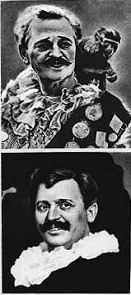 |
Russian:
The Russian clown emerged in the early 1800s with
Vladimir and Anatoly Durov, a brother comedy team. From
the poor villages, fighting cold winters and famines,
the brothers created a clowning new in form to the
Russian culture. The Durovs used as many as 50 animals
and over 15 species, including rats and cats together.
Their satire, often extremely political, caused them to
be out of favor with many officials and frequently
thrown out of a country or jailed. In the early 1900s,
preceding the 1917 Russian revolution, the avant-garde
clown became important to the new movement and was
destined to be highly influential in theatrical
development due to its political influence during the
revolution.
The Soviets later established the "School of
Clowns" awarding a college degree. Through the tempest
of revolution and in following years, many new clowns
developed out of the Durov brothers' tutelage. As in the
early court jesters, their satirical attacks on
government affected the politics of their day. Their
praise for the working class greatly aided the Bolshevik
cause, educating the people and exposing the tyranny of
the ruling classes.
The Russian clown continued to
develop aid after World War II Karandash emerged. His
antics are compared to Chaplin, however the Russian
character outwitted adversaries, avoiding the abuse that
Chaplin often encountered. In the mid 1950s, Popov
graduated from the Moscow Circus School. He tutored
under Karandash and is established as Russia's premier
clown, acclaimed by his contemporaries as a pleasing
clown character in command of many circus skills. |